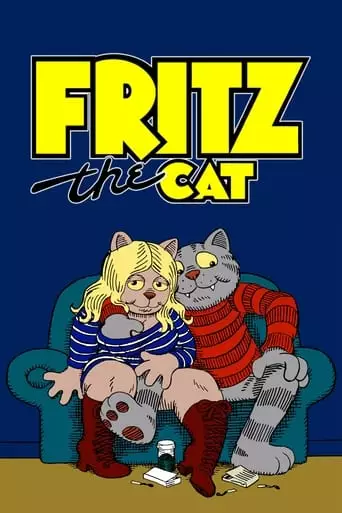
Fritz the Cat (1972) Watch Online Free
A swinging, hypocritical college student cat raises hell in a satirical vision of the 1960s.
“Fritz the Cat” is an animated film that sparked controversy and captured the spirit of the 1960s and 1970s counterculture. Directed by Ralph Bakshi and based on Robert Crumb’s underground comics, it follows the misadventures of Fritz, a college student who embodies the disillusionment and rebellion of youth. Fritz is a carefree, sexually charged anthropomorphic cat who embarks on a series of escapades that challenge societal norms and explore themes of sexual freedom, drugs, and revolution.
The film opens with Fritz participating in a protest in Washington Square Park, where he attempts to charm girls with his pretentious intellectualism. The story quickly spirals into a chaotic series of encounters, including a wild party, a confrontation with the police (depicted as pigs), a riot, and a failed revolutionary plot. Throughout, Fritz’s exploits provide a satirical commentary on the political, social, and cultural turmoil of the era. From orgies and drug-induced revelry to confrontations with authority, the film pushes the boundaries of animated content, making it the first animated film to earn an X rating.
Analysis:
“Fritz the Cat” was groundbreaking for its time, taking animation into a realm that was far from the family-friendly fare that had dominated the genre up until then. The film’s provocative content – including nudity, drug use, and political commentary – challenged the conventions of animated films, which had traditionally been seen as a medium for children. By using animals to represent different societal groups, the film boldly satirizes various aspects of American life, including race, sexuality, politics, and intellectualism.
Fritz, as the main character, is portrayed as a self-indulgent, hedonistic figure who reflects the counterculture’s skepticism toward traditional values. His journey from one hedonistic escapade to another is marked by moments of disillusionment, especially as he encounters the harsher realities of revolutionary activism and the consequences of his actions. The film critiques not only the youth’s rebellion but also the failure of their ideals, making it both a celebration and a critique of the era’s excesses.
The animation style itself is highly stylized, using exaggerated expressions and movements to highlight the absurdity of Fritz’s actions and the satirical nature of the film. This visual style helps convey the anarchic tone of the movie and aligns with the film’s subversive and rebellious spirit.
Themes:
10 Reasons to Watch Fritz the Cat:
Emotional Impact:
After watching “Fritz the Cat,” viewers are likely to experience a range of emotions. The film’s chaotic and rebellious energy might evoke excitement or a sense of liberation, especially for those familiar with the counterculture it represents. However, its brutal critiques and portrayal of disillusionment might leave some feeling uncomfortable or reflective about the failures of idealistic movements. The film’s dark humor and graphic content may also provoke mixed reactions, ranging from shock to admiration for its audacity.
Ultimately, watching “Fritz the Cat” can lead to a deep reflection on societal norms, personal freedom, and the cost of rebellion. Whether one finds it liberating or distasteful, the film leaves a lasting impact as a bold statement on the tumultuous 1960s and 1970s, making it an essential watch for those interested in the history of animation and cultural critique.
